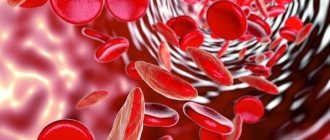Iron is responsible for many processes, among the main ones are the delivery of oxygen to organs, regulation of respiration, and metabolism. All the most important things about the mineral are in this article.
The material was commented on and checked by Natalya Polenova, family doctor, cardiologist and nutritionist at GMS Clinic
The body does not produce iron on its own; a person receives 1-2 mg of this element with food. Each of us loses approximately the same amount through dead skin and intestinal cells.
Excess iron
An overdose of iron in a healthy person is quite difficult to achieve as part of a normal diet. Iron is a rather ungrateful mineral component and is only absorbed to a small extent.
Additionally, many other food ingredients can effectively prevent this. We are talking about black tea, coffee, products containing calcium, phytic acids, fiber or polyphenols, which are almost impossible to get rid of.
This looks a little different with iron supplements. A large dose of the element is concentrated into a small tablet that is easy to swallow. Supplement overdose can result from taking too much or too many different medications, most of which contain iron.
In a healthy person, a situation in which the body cannot cope with excessive iron intake is unlikely, including due to natural protective mechanisms. This is an HFE protein that blocks the absorption of iron in the intestines when levels are high. Specific genes are responsible for its production.
Unfortunately, there are people for whom these mechanisms do not work properly. These people suffer from hemochromatosis.
Hemochromatosis is a genetically determined disease. Serious symptoms occur when there is a significant excess of iron in the tissues and hemochromatosis is detected only after 30-40 years. In women, the first symptoms of the disease and its detection may occur even later.
Why does the level of iron in the body go through the roof?
Guests
Leonid Lazebnik professor, doctor of medical sciences, therapist of the highest category, president of the Scientific Society of Gastroenterologists of Russia
Maria Vasilevskaya:
On air, “Medical Examination” is a diagnosis of our healthcare, the temperature of public opinion, pressing issues and useful advice. It’s bad when the body lacks iron, it’s even worse when this microelement is in excess, excessive accumulation of iron, hemochromatosis, leads to the most unenviable consequences: cirrhosis, diabetes mellitus, hormonal imbalance - so why does the iron level begin to go off scale, is it possible to stop this process and who is at risk? These and other questions will be answered by a therapist of the highest category, Doctor of Medical Sciences, Professor, President of the Scientific Society of Gastroenterologists of Russia Leonid Borisovich Lazebnik. Hello, Leonid Borisovich!
Leonid Lazebnik:
Hello!
Maria Vasilevskaya:
Why does the level of iron in the body go off scale?
Leonid Lazebnik:
After all, iron is contained in our red blood cells...
Maria Vasilevskaya:
So…
Leonid Lazebnik:
And if excessive breakdown of red blood cells begins, it does not have time to be absorbed.
Maria Vasilevskaya:
Why does it start?
Leonid Lazebnik:
Some kind of intoxication, some kind of anemia, so if a person has anemia, this does not mean that he has little iron in his body, it breaks down in red blood cells and is not absorbed and settles in other places - this is the first thing. Secondly, there are such congenital conditions: some enzymes begin not to repel iron in the duodenum, but to absorb it, and it enters the blood and then begins to be deposited in a variety of organs, the most accumulative organ for the body is the liver, on the left side it is healthy liver.
Maria Vasilevskaya:
The pink one is cute.
Leonid Lazebnik:
Yes, there are these pink liver cells - these are healthy cells, they accumulate a normal amount of iron, they retain it, but on the left is the liver affected by hemochromatosis, you see, there is a lot of fat there...
Maria Vasilevskaya:
Rusty liver.
Leonid Lazebnik:
Yes, fatty liver and, secondly, there are black inclusions there in an asymmetrical order, sometimes even in stripes - these are inclusions of iron, this is called hemochromatosis.
Maria Vasilevskaya:
How does iron get into the human body anyway? We don’t eat nails, do we?
Leonid Lazebnik:
We eat, firstly, enough foods that contain iron, first of all, of course, this is meat, this is buckwheat and some other types, mainly meat and buckwheat.
Maria Vasilevskaya:
Apples probably “rust”?
Leonid Lazebnik:
Not all apples: sour apples, especially those in the skin, contain iron, of course.
Maria Vasilevskaya:
How can I tell? It’s probably obvious from some symptoms: should I eat sour apples or not, how can I tell?
Leonid Lazebnik:
No, you and I can’t understand that, several studies need to be carried out: if we are talking about a serious condition, what is called “bronze” diabetes or “bronze” disease or hemochromatosis, it begins to be deposited not only in the liver, but also in the skin tissues, and the person “turns bronze”, which is why it is called “bronze” disease.
Maria Vasilevskaya:
That is, he appears to have a tan, although he has not tanned?
Leonid Lazebnik:
Yes, and one of the reasons for the increase in sugar may be the so-called “bronze” diabetes or hemochromatosis, but first the person still changes skin color.
Maria Vasilevskaya:
So this is the most important sign?
Leonid Lazebnik:
Yes, it seems that she is tanned and looks great, but symptoms of cirrhosis appear: weakness, peripheral neuropathies, memory impairment. First, the liver enlarges, then it begins to decrease in size, and here two substances need to be examined: ferritin is an indicator of the accumulation of iron in the body and transferrin is a protein that transports iron.
Maria Vasilevskaya:
Do you need to donate blood for transferrin, as you said?
Leonid Lazebnik:
Yes, you need to donate blood. There is appropriate treatment, firstly, traditionally bloodletting.
Maria Vasilevskaya:
Are these leeches or the old fashioned way, like in the Middle Ages?
Leonid Lazebnik:
No, a needle is inserted, excuse me, I’ll show you on myself, 150 or 200 milliliters of blood are released here like this - this is generally a reliable method of treatment that came to us from time immemorial, but it is a reliable method of treatment: excess blood and excess iron are removed.
Maria Vasilevskaya:
As a donor, right?
Leonid Lazebnik:
Yes, but they just pour it out.
Maria Vasilevskaya:
How often do they do this type of bloodletting?
Leonid Lazebnik:
From once a month to once every 3 months.
Maria Vasilevskaya:
If a person has high iron levels and does nothing, what will happen in the end?
Leonid Lazebnik:
It will end sadly, of course.
Maria Vasilevskaya:
Cirrhosis?
Leonid Lazebnik:
It will end in liver failure, cirrhosis of the liver. There are 3 drugs, 2 of them are very powerful, but toxic, the third drug is much softer - it is a hydrolyzate of the human placenta, it works very reliably, by the way, this is both a Japanese and our achievement.
Maria Vasilevskaya:
So this disease can simply be treated with medication?
Leonid Lazebnik:
This disease can be treated with medication, there is no need to be afraid, but first of all, first of all, do not be scared, do not panic, find an intelligent doctor...
Maria Vasilevskaya:
And get treatment.
Leonid Lazebnik:
To repair our cars, we don’t go to the first auto repair shop on the corner, we will find something that inspires confidence in us, and a doctor, find a smart doctor who would not rush to do bloodletting if necessary, yes, if there is a lot of excess blood, it will be necessary to release it, but then you will need drugs that remove iron, either block its absorption, or act gently so that you will not notice anything, and the level of ferritin in your blood will be normal.
Maria Vasilevskaya:
What preventive measures would you recommend to our viewers to prevent excess iron in the body?
Leonid Lazebnik:
Firstly, if you have anemia, you should definitely get it checked, because there are types of anemia...
Maria Vasilevskaya:
What is anemia?
Leonid Lazebnik:
Anemia: if red blood cells disintegrate excessively in the body, then you need to remember that this iron can be deposited in the liver and pancreas. Second: you don’t need... you just want to say: “Gobble up all the multivitamins in a row,” but if your body doesn’t need anything, why eat it, what the body wants, it will ask for itself, if it wants black caviar, buy 2-3 eggs...
Maria Vasilevskaya:
Unscrupulous organism.
Leonid Lazebnik:
At the end of the day, our eating habits are determined by what our microbiota wants.
Maria Vasilevskaya:
Our intestinal microflora.
Leonid Lazebnik:
Yes, our intestinal microflora means don’t eat too much, but if you have an increase in ferritin in the blood, limit yourself to meat, buckwheat and see what foods contain excess iron.
Maria Vasilevskaya:
If a person has a high iron content in the body, what changes in his lifestyle should he make in order to live better, to live a better quality of life?
Leonid Lazebnik:
If diabetes is, of course, drugs that lower blood sugar levels, various insulins and other glucose-lowering drugs, if it is cirrhosis of the liver, then monitor enzyme levels.
Maria Vasilevskaya:
Listen to your doctor in this matter.
Leonid Lazebnik:
Yes, that is, physical activity, volens nolens, is completely excluded.
Maria Vasilevskaya:
Can't you go for a walk?
Leonid Lazebnik:
I said: physical activity, not physiological, but physical activity, that means no sports, but what is associated with everyday stress, for God’s sake, just please control yourself - you don’t need to put everything in your mouth, including recommended nutritional supplements containing microelements and all sorts of multivitamins that supposedly work, think about it, don’t waste your money.
Maria Vasilevskaya:
Everything is clear, we will listen to the doctors, thank you for this conversation!
Leonid Lazebnik:
Thank you.
Maria Vasilevskaya:
Well, be healthy, it was a “Medical Examination”!
Effects of excess iron
Long-term excess iron can have serious health consequences.
Symptoms of excess iron in the body include drowsiness and fatigue. As with other nutrients, excess iron will also be felt in our digestive tract and vomiting, nausea and diarrhea may occur. Eventually, iron will begin to accumulate in the internal organs and damage them, leading to a gradual loss of function.
A damaged pancreas stops regulating carbohydrate metabolism, which leads to diabetes. Liver cirrhosis, intestinal necrosis, and joint inflammation and pain may occur.
Elevated levels of iron in the blood also contribute to the action of free radicals, which are responsible for the aging of body cells. Therefore, people affected by hemochromatosis are more prone to developing tumors and atherosclerosis.
What is hemochromatosis?
Hemochromatosis
is a hereditary disease in which iron metabolism in the body is disrupted. As a result, the trace element accumulates in excess in the pancreas, liver, spleen, myocardium, endocrine glands and skin. Because of this, carbohydrates, proteins and even DNA molecules of organs are destroyed.
Thus, iron accumulated in the liver threatens the patient with cirrhosis, liver failure, and liver cancer. If there is an excess of the microelement in the pancreas, diabetes will develop, and if there is too much iron in the heart, heart failure will develop. In addition, iron can be deposited in the pituitary gland. Failure of this organ disables the entire endocrine system. As a result, men become “more feminine” (breasts grow, testicles atrophy, etc.), and women become “more masculine” (hair growth increases, the menstrual cycle is disrupted, infertility may occur).
Symptoms of hemochromatosis:
- The most recognizable symptom of hemochromatosis is a specific gray-brown or bronze skin tone (the disease is also called “bronze diabetes”). The patient’s face, neck, arms and legs, and genitals are “painted” in such shades. At the same time, the folds of the skin and palms remain light.
- weakness, apathy, fatigue, decreased libido
- weight loss
- hair loss on the face and body
- pain in the joints and right hypochondrium.
Preparing for analysis
The study is carried out on an empty stomach
Usually the study is carried out as planned. The patient comes for analysis in the morning on an empty stomach, after 8-14 hours of complete overnight fasting, and if this condition cannot be met, no earlier than 4 hours after the last meal. You can still drink clean water. 2-3 days before the study, it is not recommended to expose yourself to heavy physical activity, including sports training. You should get more rest, go to bed earlier, avoid stress, alcohol consumption and heavy smoking. You should also not smoke in the morning before the test.
For more accurate results, 7-10 days before the analysis, you should avoid taking iron-containing preparations and foods containing large amounts of iron (seaweed, dried and fresh mushrooms, legumes, hazelnuts, buckwheat, oatmeal, almonds, rose hips, prunes, dried apricots, cocoa). When taking medications that do not contain iron, but those that can lead to an increase in iron in the blood (antibiotics, cytostatics, contraceptives, etc.), you should discuss their discontinuation with your doctor.
If discontinuation of these drugs is not possible now, you should complete the course of therapy with these medications, and then conduct an analysis, or find an alternative to them, for example, replace oral contraceptives with barrier contraceptive methods (condoms, spermicides).
If it is necessary to determine the level of iron in the blood when acute intoxication with this metal is suspected, the above rules may not be followed. Such intoxication is an indication for emergency research and treatment.
Diagnostics: what tests need to be done
Dangerous complications such as liver cirrhosis and diabetes are common, but not obligatory, consequences of hemochromatosis. You can avoid them by detecting the disease in time - a gastroenterologist will help with this. The doctor will order a blood test (biochemical, general and blood sugar test) to find out how much the normal iron levels are exceeded. And other studies - ultrasound of the abdominal organs, magnetic resonance imaging, electrocardiography, liver biopsy and x-ray of joints - will determine which organs and how much are affected by the disease.
It is advisable for the patient’s close relatives to undergo the examination as well – they are also at risk for hemochromatosis.
Complexes with this research
Female infertility Analysis of women's reproductive health 9,790 ₽ Composition
Causes of hair loss 1,890 ₽ Composition
Entry into IVF Examination when a woman enters the IVF procedure 15,030 ₽ Composition
IN OTHER COMPLEXES
- Pregnancy planning. Clinical indicators RUB 3,880
- Women's check-up No. 1 RUB 12,520
- Men's check-up No. 1 RUB 11,280
- Biochemistry of blood. 8 indicators 990 ₽
- Examination during pregnancy. 3rd trimester 5,730 ₽
Causes of hemochromatosis
Normally, our body should have from 300 to 1500 mg of iron. Moreover, every day there is a cycle: a person receives 10-20 mg of this microelement with food, but about 1 mg is absorbed - and the body loses the same amount of iron. And in patients with hemochromatosis, up to 3-4 mg of iron per day is absorbed in the gastrointestinal tract and up to 1000 mg of “excess” iron accumulates over the course of a year. The causes of hemochromatosis are mutations of a gene located on the 6th chromosome. The anomaly is inherited and affects three people out of a thousand. Mostly these “lucky ones” are men: they suffer from hemochromatosis 10 times more often than women. The disease, as a rule, does not bother both of them until they are 40-60 years old. Although sometimes the disease overcomes even at the age of 18-30 - this is juvenile hemochromatosis.
In addition to the primary
(idiopathic) hemochromatosis, inherited, is also
secondary
or acquired. Hemochromatosis can be “acquired” by people suffering from liver disease, chronic alcoholism and certain blood diseases, as well as those who have abused iron supplements and have undergone repeated blood transfusions.






